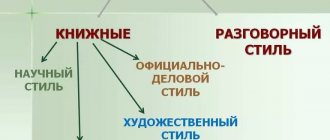A conversational style of speech is on the agenda. If you take and record our everyday conversation, you will most likely get a pun, or, better said, nothing good will come out of this idea at all. Those norms that are applicable for book speech may be completely unsuitable for colloquial speech.
In this article you will learn what a conversational style of speech is, what function it performs, read about the characteristic features, features and genres of a conversational style, and also find examples of this functional style of speech.
Features of construction and application
This style of speech is used for everyday communication in an informal setting, when the author discusses everyday issues with someone, shares impressions, experiences, and feelings.
It is used in family, friendly and informal relationships. But mostly colloquial speech is used in everyday life, so the second name for this style is everyday.
Main features
Communication between people began a very long time ago. Conversation became one of the first forms of communicative interaction. Over the course of many years, the features of the colloquial style developed; it acquired typical features and characteristics:
- Expressiveness. Interlocutors can change the timbre of their voice, tone, volume at their own request and discretion.
- Situational. In this case, speech is tied to the situation and directly depends on it. The specific setting, place and time influence the person speaking, setting the topic, speed and length of communication.
- Spontaneity. The interlocutors do not prepare for the conversation in advance and express their opinions, ideas and thoughts during the conversation. Their speech is random, they think more about the content than the beautiful delivery. Because of this, inaccuracies, negligence, ambiguity and understatement in phonetic, lexical and syntactic terms are acceptable in speech.
- Ease. The speaker is not bound by any obligations, therefore his statements are voluntary, they are not governed by any norms. A person can speak out or remain silent. He is free to change the topic or not answer an objectionable question, which is why communication is informal.
- Use of non-verbal means. Facial expressions and gestures serve as constant companions of the conversational style. They add expression, allow you to express feelings more accurately and vividly, and better convey sensations.
Where is it used?
It may seem that the conversational style has no genres and its use is not limited by anything, but this is not the case. Even in informal speech there is genre diversity, and speech itself is divided into oral and written:
- Conversation. This is the most famous and popular genre of oral speech. Conversations are resorted to in a friendly environment, with family or during acquaintances. This is a simple type of communication in a calm environment, often without a specific goal.
- Story. It is a continuous narrative, a monologue tied to a specific event or subject. The story tells about important details of what happened, interesting moments, gives an assessment, and describes impressions.
- Dispute. This oral genre serves to defend and defend one's point of view in a relaxed atmosphere.
- Letter. This is a genre of writing in which people share their emotions, explain something, or establish contact in a free form. In this case, the rule of greeting and farewell in the text is usually followed.
- A note. The genre is short and also refers to the written form of communication. It is shorter than a letter and serves to convey one information message. Usually this is how people invite each other somewhere, warn each other about something.
- Diary. In this case, there is a dialogue between the author and himself, which takes on a written form. Diary entries are distinguished by their frankness. Some people write down some creative work there: poems, notes, essays.
READ What to talk about with a guy to get his attention: topics for conversation
Vocabulary and phraseology
Linguistic means related to the lexical and phraseological level:
- The percentage of speech is clearly dominated by neutral, specific, commonly used vocabulary, also called interstyle. It is the basis of the language. Neutral vocabulary states a fact and therefore has no emotional and/or expressive overtones. This makes it a universal option for use in any style: both colloquial speech and business, scientific, journalistic. Examples of texts of a colloquial style of speech in which there is neutral vocabulary (essentially, the author’s language of literary texts, except, perhaps, fairy tales and similar genres, for the most part only contains interstyle words) are “Chameleon” by Anton Pavlovich Chekhov and “Teddy » Yuri Pavlovich Kazakov.
- Neutral colloquial vocabulary. It includes words like “doctor’s wife”, “understand” and others.
- Terminology: socio-political and general scientific, nomenclature.
- Emotional-evaluative colloquial vocabulary. It can carry a negative or positive assessment. All words from it are divided into three groups, of which: 1) the assessment is included in the very meaning of the word; 2) in a figurative sense; 3) the word contains subjective evaluative suffixes. The epithet “expressive” is also applicable to this vocabulary.
- Standardized figurative means. These include metaphors, phraseological units, hyperboles and litotes. “We drink from the cup of existence with our eyes closed” (M. Yu. Lermontov). This is an artistic metaphor, while colloquial ones have a shade of the same vernacular. An example of a conversational style of speech, text-dialogue: “What is he? - And he, as usual, says, we’ll break through! “Who else would I be worried about, but this one will really break through.” - Otherwise! Cunning like a fox! He’ll fool anyone!”
- Professionalisms and jargons. It is worth considering that each example of a piece of spoken language in fact often contains most of the devices given here: it cannot illustrate only one property. Thus, the above dialogue, in addition to the metaphor “cunning as a fox,” also has the jargon “will deceive.”
Syntactic features
Colloquial speech has clear distinctive stylistic features in terms of construction and types of sentences.
Most often, everyday style consists of simple sentences without conjunctions and complex constructions. You will not find participles or gerunds in them, but there may be homogeneous members and enumerations.
Due to the bright emotional coloring, the use of exclamatory and interrogative sentences, as well as monosyllabic and one-word sentences, which express assessment, denial, affirmation, motivation, bewilderment, is common.
Often the proposal is disrupted by additional structures. They perform a clarifying function, serve as a comment or correction. There are also introductory words and phrases with different meanings.
There are pauses in the speaker’s speech, for example, due to excitement. Sentences may not be connected in meaning due to a sudden change of topic or “flight of thought”.
Standard designs and typed forms
In everyday life, spontaneous, unprepared speech prevails - people are used to expressing themselves without caring about word forms and without thinking about them. Therefore, it is not uncommon, and even frequent, to hear standard constructions, certain stereotypes for each specific daily situation. If we consider a short text of a colloquial style of speech, examples from the store will be as follows: “Three hundred grams of cookies... Weigh it by ten. Please give me a package of butter.” From public transport: “Are you leaving at the next one? To the Airship stop, where should I get off? Will you take me to Tractors?”
Forms of etiquette are also required. After all, if the speech is unprepared and less formal, this does not mean that it is rude and extremely impolite.
“Hello, good afternoon, how are you, what’s new,” these are still well-established constructions that do not lose relevance in conversations. An example of a conversational style of speech - a small text-dialogue between comrades who have just met - will contain these expressions in 99% of cases.
Morphological features
The form, structure and frequency of use of words in colloquial speech often contradict the rules of the Russian language. But this makes the style of everyday communication unique and recognizable:
- There is a tendency not to decline the first name in combination with the surname (Semyon Semenychu), some numerals (from two hundred and forty-eight). On the contrary, indeclinable abbreviations and abbreviated names are declined (in the registry office).
- Possessive adjectives are popular (Sashka’s girlfriend, fireman’s wife).
- The primacy of verbs over nouns. Frequent use of particles and verbal interjections (boom, jump, grab).
- Nouns are used in the genitive or prepositional case ending in -u (in the workshop, give me some tea, back from vacation).
- Verb tenses are blurred. Past and future tenses are used to mean the present.
- A large number of personal and demonstrative pronouns.
- The use of imperative interjections to fully convey the feelings experienced.
- Repeating certain words to create emphasis.
- Using inversion to enhance the meaning of a particular word.
The most characteristic linguistic means of conversational style
Page 1 of 2Next ⇒
STYLISTICS
Stylistics is a branch of the science of language that studies the styles of literary language and the linguistic means that create their features.
“Styling. 1. A branch of linguistics that studies various styles (language styles, speech style, genre styles, individual style of writers). 2.
The study of expressive means of language (language stylistics) and their use in various areas of speech communication (speech stylistics).
Academician V.V. Vinogradov distinguishes: 1) stylistics of language, 2) stylistics of speech and 3) stylistics of fiction. Stylistics of language, or functional stylistics, studies the stylistic structure of language as a “system of systems”, studies functional language styles, stylistic properties of linguistic means, regardless of the specific conditions of their use. Speech stylistics analyzes the peculiarities of the functioning of linguistic means in specific conditions of their use associated with certain genres, forms, types of oral and written speech (speech in a discussion, lecture, report, press conference, conversation; editorial in a newspaper, scientific review, humorous story, greeting address, etc.). The stylistics of fiction has as its subject of study all the elements of the style of a work of art, the style of a writer, the style of a literary movement, etc., that is, “the ways of using various means of a common language individually or canonized by an entire school of writers.”
French linguist Charles Bally distinguishes between: 1) general stylistics, which studies the general stylistic problems of speech activity relating to all or most languages, 2) particular stylistics, which studies the stylistic structure of a particular national language, and 3) individual stylistics, which considers the expressive features of the speech of individual individuals.”
Speech styles
Among the variety of types of language use, two main ones stand out: spoken language and literary language (book).
Colloquial language (colloquial style of speech) is usually used orally.
Literary (book) language includes scientific, official business, and journalistic speech, which functions in certain areas of activity. Depending on this, scientific, official business, journalistic styles of speech and artistic style, or the language of fiction, differ.
The word "style" comes from the Greek.
stylos - writing stick. In ancient times, it meant a stick, a rod, pointed at one end and rounded at the other, made of wood, metal, bone. They used a sharp end to write, and used the other to erase what they had written poorly so that they could write again.
The word "style" has come to mean the quality of writing. This is the essence of stylistics - the ability to express thoughts using various linguistic means, which distinguishes one style of speech from another.
Let us briefly describe each style according to this plan:
a) the purpose of the statement;
b) scope of application;
c) speech genres;
d) means of language characteristic of the style;
e) stylistic features of speech. Conversational style:
a) used for direct, everyday communication: we share our thoughts and feelings with the people around us, exchange information on everyday issues;
b) in the sphere of everyday relations, in a relaxed, informal atmosphere;
c) friendly conversation, private conversation, notes, private letters;
d) colloquial and colloquial vocabulary;
e) characterized by emotionality, imagery, concreteness, and simplicity of speech. Scientific style:
a) communication of scientific information, scientific explanation of facts;
b) in an official setting;
c) scientific article, scientific report, educational literature, dissertation;
d) terminological and professional vocabulary;
e) strict logic, objectivity of the text, semantic accuracy; abstraction and generalization.
Formal business style:
a) message, informing;
b) in an official setting (the sphere of legislation, office work, administrative and legal activities);
c) laws, orders, decrees, resolutions, protocols, acts, certificates, instructions, announcements, business papers (statement, report, report);
d) official business vocabulary; stable, standardized figures of speech;
e) accuracy that does not allow any other interpretation.
Journalistic style:
a) the function of influence through the media;
b) in an official setting; speeches in newspapers and magazines, on radio and television, at rallies and meetings;
c) article, essay, report, feuilleton, interview, oratory;
d) socio-political vocabulary;
e) logical speech and at the same time imagery, emotionality, evaluativeness, appeal. Fiction style'.
a) image and impact on the reader;
b) novel, story, story, poem, fable, poem, drama, comedy, tragedy;
c) use of all the riches of vocabulary;
d) imagery, emotionality, concreteness of speech;
e) using the possibilities of different styles. In the style of fiction, especially in dialogues, colloquial vocabulary and other elements of conversational style are often used to characterize characters.
Conversational style of speech
The colloquial style of speech is usually understood as the peculiarities and flavor of the oral speech of native speakers of a literary language. The spoken language developed in an urban environment; it is devoid of dialectal features and has fundamental differences from the literary language.
The conversational style is presented in oral and written form - notes, private letters.
The sphere of conversational style of speech is the sphere of everyday relations, professional (oral form). Conversational style is used in everyday speech and conversations. The purpose of the conversational style is communication, exchange of thoughts and impressions.
General signs: informality, ease of communication; unpreparedness of speech, its automaticity; the predominant oral form of communication (usually dialogical), a monologue is possible.
In conversational style, extra-linguistic means play an important role: facial expressions, gestures, and the surrounding environment. Emotionality, gestures, facial expressions, the situation, the nature of the relationship between the interlocutors - all this affects the characteristics of speech, allows you to save the actual linguistic means, reduce the volume of the statement and simplify its form.
The most characteristic linguistic means of conversational style
In vocabulary and phraseology - words that have a colloquial connotation, including everyday content; specific vocabulary; a lot of words and phraseological units with expressive-emotional overtones (familiar, endearing, disapproving, ironic). Limited: abstract, foreign language origin, terminological vocabulary; book words. The overwhelming majority of words are commonly used and neutral. Synonymy is often situational.
The word-formation features of the conversational style are associated with its expressiveness and evaluativeness. Suffixes of subjective evaluation with the meaning of endearment, disapproval, magnification, etc. are widely used (sweetheart, sunshine, coldness, dirt),
with a colloquial coloring: -k-
(overnight, candle), -yaga (hard worker, hard worker), -yatina (dead meat, vulgarity), -sha (doctor’s wife, usherette).
Formation of adjectives of evaluative meaning (
big-eyed, thin, hefty), verbs
to fool around, talk, get healthy, lose weight).
To enhance expression, doubling of words is used
(big-big-big, big-eyed-big-eyed, black-black).
In morphology: verbs, personal pronouns and particles are used more often (than in the artistic style of speech) (including colloquial ones , well, after all).
The tense meanings of the verb are varied (past and future in the meaning of the present).
Verbal interjections (jump, hop, bang) are widely used.
Possessive adjectives are very common (Petya's sister, Fedorov's wife).
Participles are rare, gerunds are almost never found.
Short adjectives are rarely used. Among case formations, variants of the forms of the genitive and prepositional cases in -y (from home, on vacation, no sugar) are common.
Tendency: not to decline the first part of one’s own name
(to Ivan Ivanovich),
not to decline compound numerals
(from two hundred and thirty-five),
to decline abbreviations
(in the Russian Academy of Sciences).
Characteristic features of syntax: incomplete sentences, interrogative and imperative sentences. The order of words in a sentence is free. Simple verbal predicates, expressed by the infinitive (she’s crying again),
interjection
(and he hits the ground),
repetition of the predicate
(and does not do).
Impersonal sentences are widespread in colloquial speech.
In oral speech, pauses, the emphasis of certain words in the voice, acceleration and deceleration of the rate of speech, strengthening and weakening of the strength of the voice become of great importance.
In oral colloquial speech there are many peculiar expressions that are not characteristic of book speech, for example: People are like people; And the boat floated and floated; It's still raining,' she's a good girl! Go buy some bread. So I will listen to you! And he was also called a comrade! What a man! I found someone to be friends with! Good helper!
The conversational style of speech is characterized by rich figurative and expressive capabilities of the language. Poets, writers, and publicists often turn to the means of verbal expression.
.
“You know Gavrila, the suburban carpenter, don’t you?”
- Well, yes, we know.
- Do you know why he’s so gloomy, he’s always silent, do you know? That’s why he’s so gloomy: he went off once, my father said, - he went, my brothers, into the forest for nuts and got lost; I went, God knows where I went. He walked and walked, my brothers - no! can't find the way; and it’s night outside. So he sat down under a tree; “Come on, I’ll wait until morning,” he sat down and dozed off.
. (Turgenev).
Scientific style of speech
The scientific style of speech includes such type of literature as articles in scientific journals and collections, monographs, dissertations, encyclopedias, dictionaries, reference books, educational literature, scientific reports and lectures, speeches at scientific conferences and meetings.
The most common specific feature of this style of speech is the logic of presentation. Any coherent statement must have this quality. But the scientific text is distinguished by its emphasized, strict logic. All parts in it are strictly connected in meaning and are arranged strictly sequentially; conclusions follow from the facts presented in the text. This is done by means typical of scientific speech: connecting sentences using repeated nouns, often in combination with a demonstrative pronoun. Adverbs also indicate the sequence of development of thought: first, first of all, then, then, further;
as well as introductory words:
firstly, secondly, thirdly, finally, so, therefore, vice versa,
conjunctions:
since, because, so that, therefore.
The predominance of the conjunction emphasizes the greater connection between sentences.
Another typical feature of a scientific style of speech is accuracy. Semantic accuracy (unambiguity) is achieved by careful selection of words, the use of words in their direct meaning, and the wide use of terms and special vocabulary. In scientific style, repetition of keywords is considered the norm.
Abstraction and generality necessarily permeate every scientific text. Therefore, abstract concepts that are difficult to imagine, see, and feel are widely used here. In such texts there are often words with an abstract meaning, for example: emptiness, speed, time, force, quantity, quality, law, number, limit,
formulas, symbols, symbols, graphs, tables, diagrams, diagrams, and drawings are often used.
Even specific vocabulary here serves to denote general concepts. The psychologist must carefully...
that is, a psychologist in general;
Birch tolerates frost well,
that is, not a single object, but a tree species - a general concept. This is clearly manifested when comparing the features of the use of the same word in scientific and artistic speech. In artistic speech, a word is not a term; it contains not only a concept, but also a verbal artistic image (comparison, personification, etc.). The word of science is unambiguous and illogical.
The scientific style of speech is characterized by the plural form of abstract and real nouns: length, magnitude, frequency',
frequent use of neuter words:
education, property, meaning.
Not only nouns, but also verbs are usually used in the context of scientific speech not in their basic and specific meanings, but in a generalized abstract meaning. Words go, follow, lead, compose, indicate
I others do not denote movement itself, etc., but something else, abstract:
we are talking about problems, from here follows a conclusion, to bring it to a common denominator.
In scientific literature, especially mathematical literature, the form of the future tense is often deprived of its grammatical meaning: will
=
is, is.
Present tense verbs also do not always receive the meaning of concreteness: they are regularly used, they always indicate.
Imperfective forms are widely used.
Scientific speech is characterized by: the predominance of third-person pronouns, while the meaning of the person is weakened; frequent use of short adjectives.
However, the generality and abstractness of texts in the scientific style of speech do not mean that they lack emotionality and expressiveness. In this case, they would not have achieved their goal. The expressiveness of scientific speech differs from the expressiveness of artistic speech in that it is associated primarily with the accuracy of the use of words, the logic of presentation, and its persuasiveness. Most often, figurative means are used in popular science literature.
There is no need to confuse terms that are established in science and formed according to the type of metaphor (in biology - tongue, pestle, umbrella;
in technology -
clutch, paw, shoulder, trunk;
in geography -
base (
mountains), ridge
the use of terms for figurative and expressive purposes in a journalistic or artistic style of speech, when these words cease to be terms ( the pulse
, etc.).
To enhance expressiveness in the scientific style of speech, especially in popular science literature, in works of a polemical nature, in discussion articles, the following are used:
1) intensifying particles, pronouns, adverbs: only, absolutely, only;
2)
adjectives such as
colossal, most advantageous, one of the greatest, most difficult;
3) “problematic” questions: in fact, what kind of bodies does the cell find in the environment? what is the reason for this?
Objectivity is another sign of a scientific style of speech. Scientific theories and laws, scientific facts, phenomena, experiments and their results - all this is presented in texts related to the scientific style of speech. And all this requires quantitative and qualitative characteristics, objective and reliable. Therefore, exclamatory sentences are used very rarely. In a scientific text, a personal, subjective opinion is unacceptable; it is not customary to use the pronoun I and verbs in the first person singular. Here, vaguely personal sentences are used more often (they believe that...),
impersonal
(it is known that...),
definitely personal
(let's consider the problem...).
The main purpose of a scientific text and its vocabulary is to designate phenomena, objects, name them and explain them, and for this we need, first of all, nouns.
The most common features of scientific style vocabulary are:
a) the use of words in their literal meaning;
b) lack of figurative means: epithets, metaphors, artistic comparisons, poetic symbols, hyperboles;
c) widespread use of abstract vocabulary and terms.
In scientific speech, three layers of words are distinguished: words that are stylistically neutral, that is, commonly used, used in different styles, for example: he, five, ten; in, on, for; black, white, large; goes, happens
etc.;
words are general scientific, that is, found in the language of different sciences, and not of any one science. for example: center, force, degree, magnitude, speed, detail, energy, analogy
, etc. This can be confirmed by examples of phrases taken from texts of various sciences:
administrative center, center of the European part of Russia, city center, center of gravity, center of movement , center of the circle;
terms of any science, that is, highly specialized vocabulary; The main thing in the term is accuracy and its unambiguity.
Verbs in the 1st and 2nd person singular are practically not used in scientific texts. They are often used in literary texts.
Verbs in the present tense with a “timeless” meaning are very close to verbal nouns: splashdown
-
splashdown, rewinds - rewinds,
and vice versa:
filling - fills.
Verbal nouns convey objective processes and phenomena well, which is why they are often used in scientific texts.
There are few adjectives in a scientific text, and many of them are used as part of terms and have a precise, highly specialized meaning. In a literary text, there are more adjectives in percentage terms, and epithets and artistic definitions predominate here.
Typical scientific speeches are:
a) special revolutions of the Mendeleev type, from experience;
b) use of the word further
in the introductory word function:
Next.
This phenomenon is clearly visible...; c) the use of the words given, known, corresponding
as a means of communication;
d) use of a chain of genitive cases: Establishing the dependence of the wavelength of X-rays of an atom (Kapitsa).
IN
In scientific speech, complex sentences are used more than in other styles, especially complex sentences.
Compounds with explanatory clauses express a generalization, reveal a typical phenomenon, one or another pattern. The words are known, scientists believe, it is clear
, etc. when referring to a source, to any facts or provisions.
Complex sentences with subordinate clauses of reason are widely used in scientific speech, since science reveals the causal relationships of real phenomena. In these sentences they are used as common conjunctions (because, since, because, since),
so do book ones
(due to the fact that, due to the fact that, due to the fact that, due to the fact that, in view of the fact that, for).
In scientific speech, comparisons help to deeper reveal the essence of a phenomenon and discover its connections with other phenomena.
Frequent use of participial and participial phrases.
Scientific style.
Implements the message function. Characterized by the widespread use of terminology and abstract vocabulary, the predominant use of words in their direct, concrete meanings, the presence of special phraseology, a tendency towards complex syntactic structures, an extensive and ordered connection between the individual parts of the statement, a clear construction of paragraphs and chains of paragraphs, the use of introductory words indicating relationships between parts of a sentence, as well as those containing an assessment of the reliability of the message, the use of constructions with a generalizing generic name before listing, weak use of impersonal and elliptical sentences.
The following substyles of scientific style are distinguished: scientific-technical, scientific-business, popular science, scientific-journalistic, educational-scientific. The scientific style has a number of common features that manifest themselves regardless of the nature of the sciences themselves (natural, exact, humanities) and differences between genres of statement (monograph, scientific article, report, textbook, etc.), thereby creating the opportunity to talk about the specifics of the style in in general.
1Next ⇒
Recommended pages:
Use the site search:
Lexical means
Of course, colloquial speech has the most striking differences due to the abundance of special words in it, which are acceptable and appropriate only here. The linguistic palette of everyday style is bright and varied due to its richness in emotions. Often, familiar literary and artistic means and techniques are not enough to express the full range of feelings:
- Wide use of stress, intonation, changes in timbre and rhythm of the voice to add additional color to speech.
- An abundance of colloquial vocabulary, vernacular, jargon, vulgarisms (right now, hot, hard worker, minibus, mobile, cash).
READ How to become sociable: effective practices and recommendations from a psychologist
- Frequent phraseological phrases that are in the nature of evaluative generalizations (the hunchbacked grave will correct), the use of words in a figurative meaning (window - break, hat - mistake).
- The merging of a word with its meaning or assessment, when it is clear without additional explanation (opener, trickster, good fellow, smart guy).
- The use of words with diminutive or augmentative suffixes (blushing, pretty, little book, little chair).
- Simplification and shortening of long words or names (grade book - grade book). Borrowing foreign language vocabulary (lol, fake, hype). Addition of words (slow-witted, parasite).
- Multi-prefixed verbs with expressive coloring (hold up, don't get enough sleep, throw away).
Vernacular
This group of words and expressions does not fit into the norms and framework of literary speech. It carries shades of simplification, rudeness, and reduction of meaning.
Some scientists distinguish vernaculars into a separate lower layer of vocabulary, since they are used by people to convey a special attitude towards a subject or object, that is, they act as a full-fledged stylistic linguistic unit. The second group of researchers classifies vernaculars as a special group that goes beyond the literary language.
The use of colloquial words is deliberate when it is included in the narrative by educated people in order to give the story a special tone, specific coloring, and imagery. This is what publicists, journalists, speakers, and politicians do. In addition, this is found everywhere in the everyday speech of the average city resident. But even those deprived of education can use vernaculars. This situation is already deliberate in nature, when there is not enough intelligence and vocabulary to express thoughts differently.
Colloquial speeches are quickly remembered due to their vivid meanings. They are individual, often do not have synonyms, related or cognate words.
Jargonisms
In modern Russian, there are three groups of slang words: youth slang, professional slang (among workers' organizations - construction workers, factory workers, truck drivers) and camp or prison slang (it is used in prisons).
READ Telephone conversation: features and methods of remote communication
Slang is most widespread in everyday speech. The sources of its occurrence are considered to be student communities, schools, and gymnasiums. Its appearance is associated with the desire of young people to stand out and be different from those around them. All slang words have synonyms in the literary language (dormitory - hostel, correspondence - distance learning, kurach - course work, teacher - teacher). Jargon also includes words that convey the attitude or state of the speaker (high, awesome, laugh, labor, cool).
Vulgarisms
These are the most brightly colored words allowed in speech. Vulgarisms are rude, aggressive or even vulgar in nature. They are far beyond the boundaries of literary language, but their use is sometimes acceptable as an additional artistic device.
Vulgarisms include all curses, abusive expressions, words that convey strong negative emotions, taboo words and blasphemy (die - die, lupals - eyes, eat - eat, muzzle - face).
The presence of a large number of vulgarisms in speech indicates a low culture of behavior, lack of education and spirituality.
Style examples
Spoken speech can be heard everywhere every day. This is a way of informal communication for most.
An example from everyday communication between friends
- How was your weekend?
- Great! Laces went to the dacha to work as a farmhand on potatoes. And we got together with the boys, first we hung out at home, then we went for a walk in the park. It's a shame you weren't there. Why didn't you come to me?
— The course student wrote, otherwise it was due on Monday, and I didn’t even have half of it. I've been fussing over him all weekend. Thank God, I passed it calmly! Now you can have fun!
An example from Russian literature
The work of A.P. Chekhov “Revenge”.
- Open it, damn it! How long will I have to remain numb in this through wind? If you knew that it was twenty degrees below zero in your corridor, you wouldn’t have made me wait so long! Or maybe you don't have a heart?
Conversational style ad
Hello! You are reading this, which means you are looking for a job. Isn't that right, buddy? We suggest you slow down and get acquainted with our offer. Why come to us? Keep your fingers crossed: money, girls, the opportunity to create your own fan club, room for creativity and experimentation, your own powerful piece of hardware with a 25-inch screen. There will be no time to be bored - we promise! Don't wait, click the "Apply" button right now!
Phonetics
The linguistic means that are used at the phonetic level of the language in a conversational style include two main features:
- Simplification, truncation, compression, that is, an incomplete type of pronunciation. This is not a necessary property that a conversational style of speech can have. Examples of texts (5th grade, by the way, in some regions study this book as part of the school curriculum) are “Harry Potter and the Philosopher’s Stone,” “Harry Potter and the Chamber of Secrets” and the rest of this series. The vernacular trait is clearly expressed in the character Hagrid. Quote from “...Prisoner of Azkaban”: “The first thing he did this morning... was his resignation. I can’t, I say, put it at risk if... well, this happens again.” Unfortunately, Russian translators did not fully convey all the simplified word forms; this is more evident in the original text, but even in this quote one can already distinguish “grit,” which means “says.”
- Intonation is a purely individual feature that emotionally colors any, even stereotypical, construction. An example of a colloquial style of speech is a small text of the story “A Hypothetical Case” by the author O'Henry: “Will you be Mr. Phineas K. Gooch?” - said the visitor, and in the tone of his voice and intonation there was at once a question, a statement and a condemnation.









